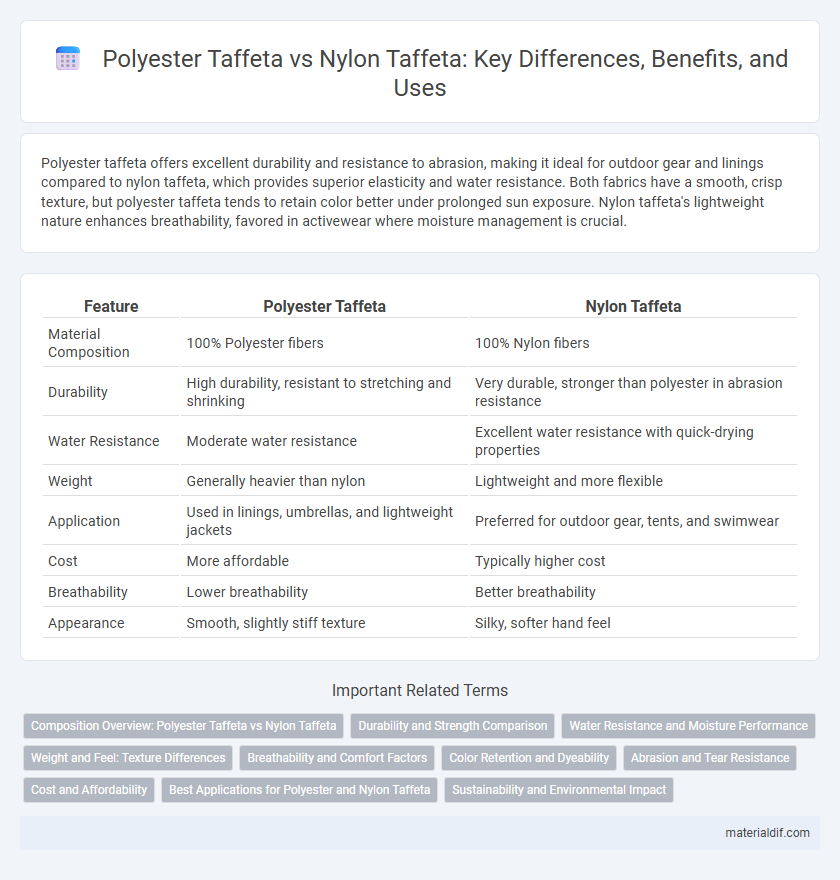Polyester taffeta offers excellent durability and resistance to abrasion, making it ideal for outdoor gear and linings compared to nylon taffeta, which provides superior elasticity and water resistance. Both fabrics have a smooth, crisp texture, but polyester taffeta tends to retain color better under prolonged sun exposure. Nylon taffeta's lightweight nature enhances breathability, favored in activewear where moisture management is crucial.
Table of Comparison
| Feature | Polyester Taffeta | Nylon Taffeta |
|---|---|---|
| Material Composition | 100% Polyester fibers | 100% Nylon fibers |
| Durability | High durability, resistant to stretching and shrinking | Very durable, stronger than polyester in abrasion resistance |
| Water Resistance | Moderate water resistance | Excellent water resistance with quick-drying properties |
| Weight | Generally heavier than nylon | Lightweight and more flexible |
| Application | Used in linings, umbrellas, and lightweight jackets | Preferred for outdoor gear, tents, and swimwear |
| Cost | More affordable | Typically higher cost |
| Breathability | Lower breathability | Better breathability |
| Appearance | Smooth, slightly stiff texture | Silky, softer hand feel |
Composition Overview: Polyester Taffeta vs Nylon Taffeta
Polyester taffeta is composed of synthetic polyester fibers that provide durability, wrinkle resistance, and water repellency, making it ideal for outdoor apparel and linings. Nylon taffeta contains nylon fibers known for exceptional strength, elasticity, and abrasion resistance, offering superior performance in activewear and parachutes. Both fabrics have a smooth, tightly woven structure, but polyester taffeta typically withstands UV exposure better, while nylon taffeta excels in tensile strength and flexibility.
Durability and Strength Comparison
Polyester taffeta exhibits superior durability and resistance to abrasion compared to nylon taffeta, making it ideal for heavy-duty applications and outdoor gear. Both fabrics offer high tensile strength, but polyester maintains its integrity better under prolonged exposure to UV light and moisture. Nylon taffeta provides slightly higher elasticity, yet polyester's dimensional stability ensures longer-lasting performance in challenging environments.
Water Resistance and Moisture Performance
Polyester taffeta offers superior water resistance compared to nylon taffeta due to its hydrophobic fiber structure, making it ideal for outdoor apparel and gear exposed to wet conditions. Nylon taffeta, while less water-resistant, excels in moisture-wicking and faster drying properties, enhancing comfort during physical activities. Both fabrics provide durable performance, but polyester taffeta is preferred for applications prioritizing water repellency and durability.
Weight and Feel: Texture Differences
Polyester taffeta typically has a slightly heavier weight compared to nylon taffeta, offering a more substantial and durable feel ideal for outerwear and linings. The texture of polyester taffeta is smoother and more crisp, providing a luxurious, silk-like sheen, while nylon taffeta feels lighter and more flexible with a subtle gloss. These differences in weight and tactile qualities influence the choice between polyester and nylon taffeta for applications requiring either durability or softness.
Breathability and Comfort Factors
Polyester taffeta offers moderate breathability and moisture-wicking properties, making it suitable for lightweight jackets and linings where comfort during physical activity is essential. Nylon taffeta, while slightly more durable and water-resistant, generally provides less breathability, which may lead to increased heat retention and less comfort in warm conditions. Both fabrics are smooth and lightweight but polyester excels in moisture management, enhancing overall comfort in active wear.
Color Retention and Dyeability
Polyester taffeta offers superior color retention due to its hydrophobic properties and resistance to UV degradation, making it ideal for vibrant, long-lasting hues. Nylon taffeta, while highly dyeable with a wider range of colors and richer saturation, tends to fade faster when exposed to sunlight and frequent washing. The molecular structure of polyester allows it to hold dyes more firmly, ensuring colors remain bright and resist bleeding over time.
Abrasion and Tear Resistance
Polyester taffeta offers superior abrasion resistance compared to nylon taffeta, making it more durable for applications involving frequent friction. Nylon taffeta provides higher tear resistance, which enhances its performance in situations where fabric stress is concentrated. Both materials excel in different aspects of durability, with polyester taffeta favored for longevity under wear and nylon taffeta preferred for resisting rips and punctures.
Cost and Affordability
Polyester taffeta typically costs less than nylon taffeta, making it a more affordable option for budget-conscious buyers. The production process of polyester fibers is generally less expensive due to the availability of raw materials and lower energy consumption. Nylon taffeta, while more durable and lightweight, often carries a higher price tag due to its superior strength and elasticity.
Best Applications for Polyester and Nylon Taffeta
Polyester taffeta excels in outdoor gear and linings due to its superior moisture resistance, durability, and affordability, making it ideal for jackets, tents, and backpacks. Nylon taffeta offers higher strength, abrasion resistance, and a lightweight feel, best suited for performance sportswear, parachutes, and inflatable products. Both fabrics provide water-repellent finishes, but polyester's UV resistance favors long-term outdoor exposure, whereas nylon's elasticity enhances flexibility in activewear.
Sustainability and Environmental Impact
Polyester taffeta is derived from petroleum-based synthetic fibers and typically has a larger carbon footprint compared to nylon taffeta, which, although also synthetic, is often produced with more energy-efficient methods. Both materials pose challenges in biodegradability, but advancements in recycling technologies have made post-consumer polyester taffeta more sustainable through fiber regeneration processes. Nylon taffeta can release nitrous oxide, a potent greenhouse gas, during production, whereas polyester's production emits more CO2, influencing environmental impact assessments in textile sustainability.
Polyester Taffeta vs Nylon Taffeta Infographic

 materialdif.com
materialdif.com